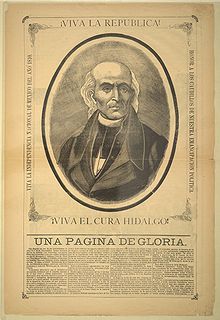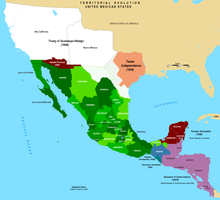Courtesy: Wikipedia
Main article: History of Mexico
Campfire remains in the Valley of Mexico have been radiocarbon-dated to 21,000 BCE, and a few chips of stone tools have been found near the hearths, indicating the presence of humans at that time.[37] Around 9,000 years ago, ancient indigenous peoples domesticated corn and initiated an agricultural revolution, leading to the formation of many complex civilizations. Between 1,800 and 300 BCE, many matured into advanced pre-Columbian Mesoamerican civilizations such as: the Olmec, the Teotihuacan, the Maya, the Zapotec, the Mixtec, the Toltec and the Aztec, which flourished for nearly 4,000 years before the first contact with Europeans.
These civilizations are credited with many inventions and advancements in fields such as architecture (pyramid-temples), mathematics, astronomy, medicine and theology. The Aztecs were noted for practicing human sacrifice on a large scale.[38] At its peak, Teotihuacan, containing some of the largest pyramidal structures built in the pre-Columbian Americas, had a population of more than 150,000 people.[39] Estimates of the population before the Spanish conquest range from 6 million to 25 million.[40][41]
In the early 16th century, from the landing of Hernán Cortés, the Aztec civilization was invaded and conquered by the Spaniards.[42] Unintentionally introduced by Spanish conquerors, smallpox ravaged Mesoamerica in the 1520s, killing millions of Aztecs,[43] including the emperor, and was credited with the victory of Hernán Cortés over the Aztec empire.[44] The territory became part of the Spanish Empire under the name of New Spain. Much of the identity, traditions and architecture of Mexico were created during the colonial period.
On September 16, 1810, independence from Spain was declared by priest Miguel Hidalgo y Costilla, in the small town of Dolores, Guanajuato.[45] The first insurgent group was formed by Hidalgo, the Spanish viceregal army captain Ignacio Allende, the militia captain Juan Aldama and "La Corregidora" Josefa Ortiz de Domínguez. Hidalgo and some of his soldiers were captured and executed by firing squad in Chihuahua, on July 31, 1811. Following his death, the leadership was assumed by priest José María Morelos, who occupied key southern cities.
In 1813, the Congress of Chilpancingo was convened and, on November 6, signed the "Solemn Act of the Declaration of Independence of Northern America". Morelos was captured and executed on December 22, 1815. In subsequent years, the insurgency was near collapse, but in 1820 Viceroy Juan Ruiz de Apodaca sent an army under the criollo general Agustín de Iturbide against the troops of Vicente Guerrero. Instead, Iturbide approached Guerrero to join forces, and in 1821 representatives of the Spanish Crown and Iturbide signed the "Treaty of Córdoba" and the "Declaration of Independence of the Mexican Empire", which recognized the independence of Mexico under the terms of the "Plan of Iguala".

Benito Juárez is generally regarded as Mexico's greatest president for resisting the French occupation, overthrowing the Empire, and restoring the Republic, as well as for his role in modernizing the country.
General Antonio López de Santa Anna, a centralist and two-time dictator, approved the Siete Leyes in 1836, a radical amendment that institutionalized the centralized form of government. When he suspended the 1824 Constitution, civil war spread across the country, and three new governments declared independence: the Republic of Texas, the Republic of the Rio Grande and the Republic of Yucatán.
Texas successfully achieved independence and was annexed by the United States. A border dispute led to the Mexican–American War, which began in 1846 and lasted for two years; the War was settled via the "Treaty of Guadalupe-Hidalgo", which forced Mexico to give up nearly half of its land to the U.S., including California and New Mexico. A much smaller transfer of territory in parts of southern Arizona and New Mexico — the Gadsden Purchase — occurred in 1854. The Caste War of Yucatán, the Mayan uprising that began in 1847,[47] was one of the most successful modern Native American revolts.[48] Maya rebels, or Cruzob, maintained relatively independent enclaves until the 1930s.[49]
Dissatisfaction with Santa Anna's return to power led to the liberal "Plan of Ayutla", initiating an era known as La Reforma, after which a new Constitution was drafted in 1857 that established a secular state, federalism as the form of government, and several freedoms. As the conservadores refused to recognized it, the War of Reform began in 1858, during which both groups had their own governments. The war ended in 1861 with victory by the Liberals, led by Amerindian President Benito Juárez. In the 1860s Mexico underwent a military occupation by France, which established the Second Mexican Empire under the rule of Habsburg Archduke Ferdinand Maximilian of Austria with support from the Roman Catholic clergy and the conservadores, who later switched sides and joined the liberales. Maximilian surrendered, was tried on June 14 and was executed on June 19, 1867.

Venustiano Carranza, one of the leaders of the Mexican Revolution and supporter of the 1917 Constitution.
20th century
A likely electoral fraud that led to Diaz's fifth reelection sparked the 1910 Mexican Revolution, initially led by Francisco I. Madero.Díaz resigned in 1911 and Madero was elected president but overthrown and murdered in a coup d'état two years later directed by conservative general Victoriano Huerta. That event re-ignited the civil war, involving figures such as Francisco Villa and Emiliano Zapata, who formed their own forces. A third force, the constitutional army led by Venustiano Carranza, managed to bring an end to the war, and radically amended the 1857 Constitution to include many of the social premises and demands of the revolutionaries into what was eventually called the 1917 Constitution. It is estimated that the war killed 900,000 of the 1910 population of 15 million.[51][52]
Assassinated in 1920, Carranza was succeeded by another revolutionary hero, Álvaro Obregón, who in turn was succeeded by Plutarco Elías Calles. Obregón was reelected in 1928 but assassinated before he could assume power. In 1929, Calles founded the National Revolutionary Party (PNR), later renamed the Institutional Revolutionary Party (PRI), and started a period known as the Maximato, which ended with the election of Lázaro Cárdenas, who implemented many economic and social reforms, and most significantly expropriated the oil industry into PEMEX on March 18, 1938, but sparked a diplomatic crisis with the countries whose citizens had lost businesses by Cárdenas radical measure.
Between 1940 and 1980, Mexico experienced a substantial economic growth that some historians call the "Mexican Miracle".[53] Although the economy continued to flourish, social inequality remained a factor of discontent. Moreover, the PRI rule became increasingly authoritarian and at times oppressive[54] (i.e.: the 1968 Tlatelolco massacre,[55] which claimed the life of around 30–800 protesters).[56]

NAFTA Initialing Ceremony, October 1992. From left to right (standing) President Carlos Salinas de Gortari, President George H. W. Bush, Prime Minister Brian Mulroney. (Seated) Jaime Serra Puche, Carla Hills, Michael Wilson.

Vicente Fox was the first president from an opposition party to win the presidential election in over 70 years.
Salinas embarked on a program of neoliberal reforms which fixed the exchange rate, controlled inflation and culminated with the signing of the North American Free Trade Agreement (NAFTA), which came into effect on January 1, 1994. The same day, the Zapatista Army of National Liberation (EZLN) started a two-week-lived armed rebellion against the federal government, and has continued as a non-violent opposition movement against neoliberalism and globalization.
In December 1994, a month after Salinas was succeeded by Ernesto Zedillo, the Mexican economy collapsed, with a rapid rescue packaged authorized by U.S. President Bill Clinton and major macroeconomic reforms started by president Zedillo, the economy rapidly recovered and growth peaked at almost 7% by the end of 1999.[60]
In 2000, after 71 years, the PRI lost a presidential election to Vicente Fox of the opposition National Action Party (PAN). In the 2006 presidential elections, Felipe Calderón from the PAN was declared the winner, with a razor-thin margin over leftist politician Andrés Manuel López Obrador of the Party of the Democratic Revolution (PRD). López Obrador, however, contested the election and pledged to create an "alternative government".[61]



